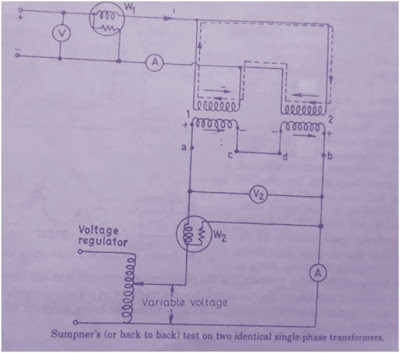This article outlines the Load Test of Transformer. Load Test of Transformer is also known as Back to Back Test or Sumpner’s Test.
Load Test of a Transformer is basically carried out for determining the maximum temperature rise of the Transformer. However is not viable to conduct this test by connecting the secondary of the Transformer to rated load. In case of small Transformer, rated load can be connected to the secondary of Transformer but for large Transformer, rated load capable of consuming rated power is not easily available and also this will lead to wastage of energy. Therefore the best and smart way to load a Transformer is to conduct Back to Back Test or Sumpner’s Test. It shall be noted here that, Back to Back Test or Sumpner’s test can also be conducted for calculating the efficiency of a Transformer but it is better to calculate the efficiency of Transformer using Open Circuit Test and Short Circuit Test of Transformer as this will give more accurate result. In this post we will focus on Back to Back Test or Sumpner’s Test of single phase Transformer.
The Back to back Test on single phase transformer requires two identical Transformers. In this Test, the primaries of two Transformers are connected in parallel and are energized at rated voltage and frequency as shown in figure below.
Now, if we short the secondary of Transformers, no current will flow as Vab = 0 and therefore the reading of wattmeter W1 will not change. Now we will inject voltage in the secondary circuit by means of voltage regulator, fed from the source connected to the primary or from a separate source. The injected voltage is regulated till rated current flow in the secondary circuit. By Transformer Action, rated current now will start flowing in primary circuit too. Note here that, the full load or rated current in primary completes its path as shown by the dotted line in figure above. As this full load current in the primary is not flowing through the current coil of the wattmeter, therefore the reading of wattmeter W1will remain unaltered.
The reading of voltmeter V2will now show the voltage drop due to leakage impedance of both the Transformers. As full load current is flowing in the secondary circuit, the wattmeter W2 will read the total full load ohmic loss of Transformers.
Let us suppose that,
Pc = Core Loss in individual Transformer
Poh = Ohmic Loss in individual Transformer
then,
Reading of wattmeter W1=2Pc
Reading of wattmeter W2= 2Poh
Therefore, from the above two reading efficiency of each Transformer can be determined.
From the above discussion, it is quite clear that, even though Transformer is not connected to any load in Sumpner’s Test, rated current is flowing in the primary as well as in the secondary of Transformers and hence full load ohmic and core loss is taking place. If temperature rise of the two Transformers is to be measured, then two Transformers are kept under rated loss condition for several hours till maximum stable temperature is reached.
